Stellar Evolution
Changes in a stars luminosityBasic property used to characterize stars, luminosity is defined as the total energy radiated by a star each second. An object’s luminosity is often compared to that of the Sun (Lsun = 4 × 1033 ergs/s = 3.9 × 1026 Watts). Luminosity has the same units as power (energy per Click on Term to Read More and temperature over its lifetime; conventionally, plotted on an Hertzsprung-Russell (HR) diagram. All stars, irrespective of their mass spend most of their lifetime on the main sequence. The more massive a starSelf-luminous object held together by its own self-gravity. Often refers to those objects which generate energy from nuclear reactions occurring at their cores, but may also be applied to stellar remnants such as neutron stars., the more luminous and hotter it is. As all stars age, they enter a giant phase (their brightness remains constant, but the effective surface temperature decreases, 7 → 9). This reflects a change in the fusionProcess in which two lighter atomic nuclei combine to form a heavier atomic nucleus. Very high temperatures are normally required in order for atomic nuclei to collide with sufficient energy to overcome the Coulomb barrier (their mutual electrostatic repulsions). Fusion that occurs under high-temperature conditions is called thermonuclear fusion. Fusion Click on Term to Read More processes at work within the star: outer layers expand and are no longer of sites nuclear burning. As these layers cool, the star drifts towards the right side of the HR diagram. Subsequent evolution depends on the mass of the star.
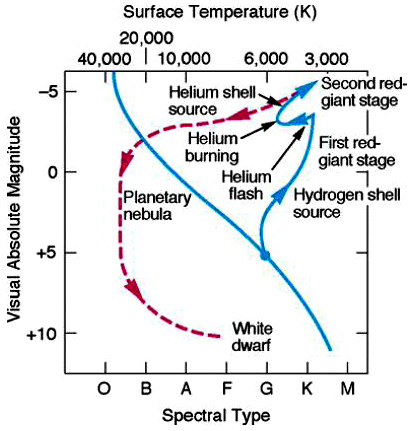
Image source: http://www.astro.ljmu.ac.uk/courses/phys134/hrdiag.html.
For a ~1 Msun star, when H burning ends, the coreIn the context of planetary formation, the core is the central region of a large differentiated asteroid, planet or moon and made up of denser materials than the surrounding mantle and crust. For example, the cores of the Earth, the terrestrial planets and differentiated asteroids are rich in metallic iron-nickel. Click on Term to Read More temperature is insufficient for He burning to occur. With no source of energy production in the core there is no longer any outward radiative pressure to resist gravitational collapse, and the outer regions of the star start to collapse (9 → 10). Collapse raises the temperature in the H shell and H fusion occurs.
Luminosity increases as the core continues to collapse and the temperature in the H shell keeps increasing. The burning shell also provides pressure on the outer layers of the star and causes them to expand. As the layers expand they cool and the star appears to become redder.
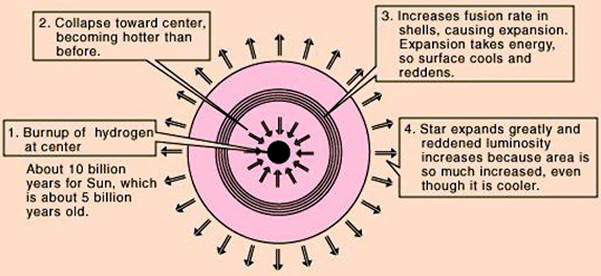
Image source: http://hyperphysics.phy-astr.gsu.edu/hbase/astro/redgia.html#c1.
After just a few million years the H shell runs out of fuel. Once again the star contracts under its own weight. The compact core may flash into life for a short period and He be fused into C (10). The energy released in the He flash reaches the outer layers and the star becomes a red supergiant (11). Up to half its mass is thrown out into space and seen as a planetary nebulaAn immense interstellar, diffuse cloud of gas and dust from which a central star and surrounding planets and planetesimals condense and accrete. The properties of nebulae vary enormously and depend on their composition as well as the environment in which they are situated. Emission nebula are powered by young, massive Click on Term to Read More (12) leaving a white dwarfRemnant of a star with mass <8 Msun. White dwarfs have masses <1.4 Msun (the Chandrasekhar mass) and are supported by electron degeneracy pressure. White dwarfs have radii ~Rearth (<0.02 Rsun) and densities ~105-6 g/cm3. No nuclear fusion or gravitational contraction occurs in white dwarfs, they shine by residual heat. behind.
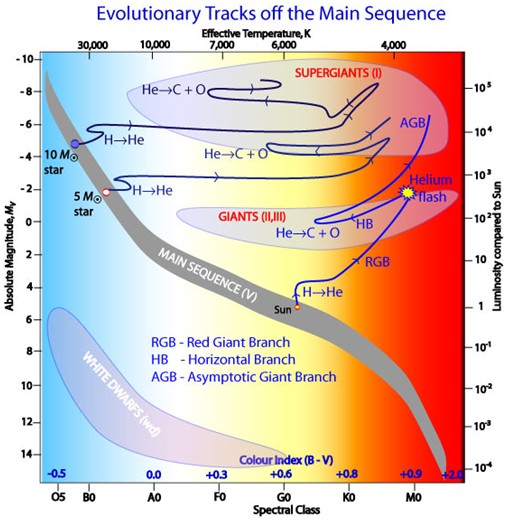
Image source: http://www.nicolascretton.ch/Astronomy/images/HR_post_MS_sun_track.jpg.
Stars with a mass of between 8 and 20 Msun have a more complex evolution. Initially, they evolve in the same way as low mass stars, turning into red giants and undergoing a core He burning phase. However, He burning is no longer the end phase of stellar evolution. When He in the core is exhausted, the additional mass allows stellar collapse to take place and the outer layers to reignite. A cross section through the star at this point would show an outer shell of H burning, an inner shell of He burning, and the core where C burning is taking place. Once the C supply is exhausted, O begins to fuse into Ne; the He shell becomes a C burning shell, the H shell a He burning shell and a new outer layer of H burning forms. Subsequently, Ne can fuse into Mg, into Si, and so on to Cr and Fe.
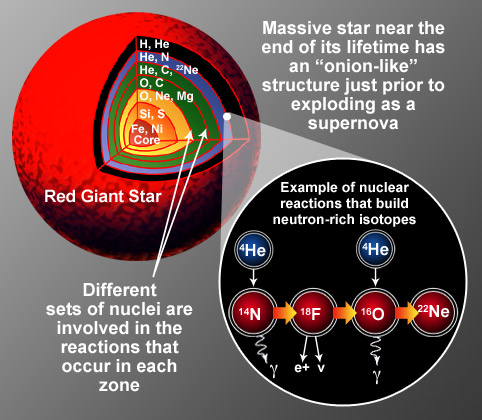
Image source: https://lasers.llnl.gov/programs/science_at_the_extremes/laboratory_astrophysics/.
Each of these stages produces less energy than the previous one and lasts for a shorter. During these final stages the star expands to thousands of times the diameter of the SunOur parent star. The structure of Sun's interior is the result of the hydrostatic equilibrium between gravity and the pressure of the gas. The interior consists of three shells: the core, radiative region, and convective region. Image source: http://eclipse99.nasa.gov/pages/SunActiv.html. The core is the hot, dense central region in which the, becoming a red supergiant like Betelgeuse. Iron is the end of the exothermicA chemical or nuclear reaction that liberates heat energy so that heat flows from the system to the surroundings. Exothermic reactions cause an increase in temperature. A classic exothermic reaction is the mixing of a strong acid with water. In order to prevent an explosive and dangerous reaction, the acid Click on Term to Read More fusion road: to fuse iron into heavier elements is an endothermicA chemical reaction that is accompanied by or requires the absorption of energy from its environment. A classic endothermic reaction is the melting of ice cubes in a cup of water. Click on Term to Read More reaction. FissionBreaking apart of a body into smaller fragments. In nuclear physics, fission refers to splitting of a heavy atomic nucleus into two or more lighter nuclei with an associated release of energy. The mass of the nucleus before fission is greater than the combined masses of the resulting fragments; the Click on Term to Read More of Fe into lighter elements also requires an input of energy. The core cools, drawing heat from its surroundings to power the fusion; the outward radiative pressure, which had supported the star for many millions of years, ceases and the star undergoes free fallMeteorite seen to fall. Such meteorites are usually collected soon after falling and are not affected by terrestrial weathering (Weathering = 0). Beginning in 2014 (date needs confirmation), the NomComm adopted the use of the terms "probable fall" and "confirmed fall" to provide better insight into the meteorite's history. If Click on Term to Read More gravitational core collapse until it reaches nuclear densitiesMass of an object divided by its volume. Density is a characteristic property of a substance (rock vs. ice, e.g.). Some substances (like gases) are easily compressible and have different densities depending on how much pressure is exerted upon them. The Sun is composed of compressible gases and is much Click on Term to Read More (~1014 g/cm3). The core, which represents a large percentage of the stellar mass, exceeds the 1.44 Chandrasekhar limit for a white dwarf. Protons and electrons in the core are compressed into neutrons, yielding a
sphere the size of a large city and the densityMass of an object divided by its volume. Density is a characteristic property of a substance (rock vs. ice, e.g.). Some substances (like gases) are easily compressible and have different densities depending on how much pressure is exerted upon them. The Sun is composed of compressible gases and is much Click on Term to Read More of an atomic nucleusCore of an atom, where nearly the entire mass and all positive charge is concentrated. It consists of protons and neutrons. Click on Term to Read More, held up by neutronCharge-neutral hadron with a mass of 1.6748 x 10-27 kg, equivalent to 939.573 MeV, and an intrinsic angular momentum, or spin, of ½ (in units of h/2π). The neutron is a nucleon, one of the two basic constituents of all atomic nuclei (apart from 1H, which consists of a single Click on Term to Read More degeneracy pressure: a neutron starDense ball of neutrons that remains at the core of a star after a supernova explosion has destroyed the rest of a star with mass 8-18 (?) Msun. A neutron star has mass ~2-3 Msun, density ~1014 g/cm3, and is supported by neutron degeneracy pressure. Typical neutron stars are 10-20 Click on Term to Read More. Core collapse produces a shock waveAbrupt perturbation in the temperature, pressure and density of a solid, liquid or gas, that propagates faster than the speed of sound. that blasts out through the star releasing an enormous amount of energy in a few seconds, equivalent to ~1028 Mton of TNT. The outer layers of the star become superheated plasmas with temperatures high enough to fuse Fe and heavier elements. These outer layers brighten rapidly and are ejected into the interstellar mediumMaterial between the stars, consisting of gas, dust and cosmic rays (high energy charged particles moving at nearly the speed of light). It comprises ~10% of visible matter in the disk of our Galaxy (Milky Way). Until recently it was generally assumed that silicates in the ISM were amorphous, but Click on Term to Read More at speeds approaching the speed of lightSpeed at which electromagnetic radiation propagates in a vacuum. Although referred to as the speed of light, this should be more properly called the 'speed of a massless particle’ as it is the speed at which all particles of zero mass (not only photons, but gravitons and massless neutrinos if. Such an event is a Type II supernovaStellar explosion that expels much or all of the stellar material with great force, driving a blast wave into the surrounding space, and leaving a supernova remnant. Supernovae are classified based on the presence or absence of features in their optical spectra taken near maximum light. They were first categorized Click on Term to Read More.
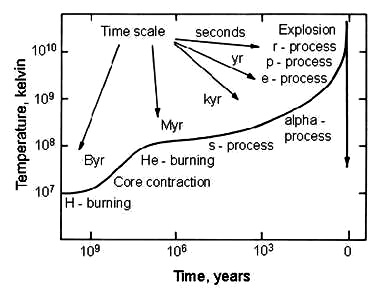
Image source: http://www.onafarawayday.com/Radiogenic/Ch1/Ch1-2.htm.
Stars with over 20 Msun evolve in the same way as their slightly less massive companions dying in a supernova explosion, but the core becomes a black holeMaximally gravitationally collapsed object predicted to exist by the theory of general relativity, from which no material object, light or signal of any kind can escape. Many black holes form when a high mass supergiant star explodes in a supernova explosion at the end of its life. A star probably Click on Term to Read More. A neutron star can mass up to around 3 Msun. After this point neutron degeneracy pressure is no longer sufficient to prevent core collapse. With nothing left to resist collapse the core condenses into an infinitely small, infinitely dense point called a black hole (singularityRegions of space where the density of matter, or the curvature of space-time, becomes infinite and the concepts of space and time cease to have any meaning. Singularities are predicted to occur in all black holes and in certain models of the Universe. For example, open Friedmann models of the).






